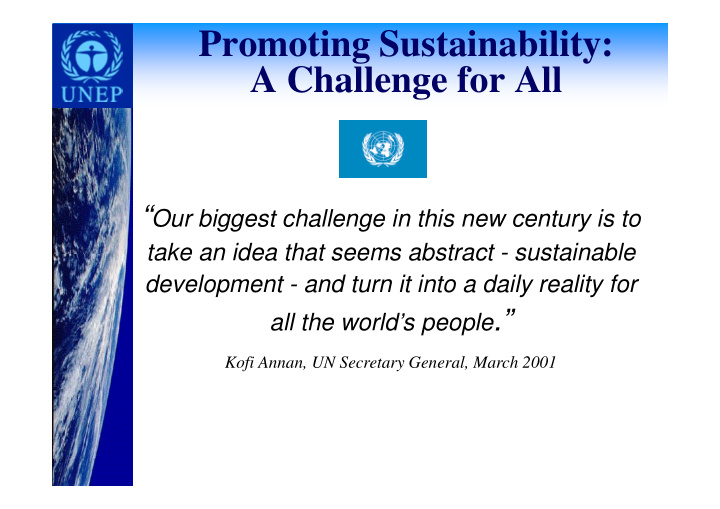



Promoting Sustainability: A Challenge for All “ Our biggest challenge in this new century is to take an idea that seems abstract - sustainable development - and turn it into a daily reality for all the world’s people .” Kofi Annan, UN Secretary General, March 2001
What is the Problem? “ The main cause of the deterioration of the global environment is the unsustainable patterns of consumption and production , particularly in industrialized countries, which is a matter of grave concern, aggravating poverty and imbalances.” Agenda 21 (Chap. 4.3), Earth Summit, Rio 1992
What is the Magnitude? “It is simply impossible for the world as a whole to sustain a Western level of consumption for all. In fact, if 7 billion people were to consume as much energy and resources as we do in the West today we will need more than one planet to satisfy all our needs.” Gro Harlem Brundtland, 1994
Deterioration Continues • Between 1990 - 1995, 65 million ha of forest (the size of 130 mil football fields) were lost. • In 1996 , 25% of the world’s mammal species and 11% bird species were at a significant risk of total extinction. • The global marine fish catch almost doubled between 1975-1995 and now an estimated 60% of fisheries are at or near the point at which yields decline. • 400 million tones of hazardous waste is created from chemicals each year (with 75% attributed to the industrial countries)
Implementation Gap Fundamental changes in the way societies produce and consume are indispensable for achieving global sustainable development. All countries should promote sustainable consumption and production patterns ... Governments, relevant international organizations, the private sector and all major groups should play an active role in changing unsustainable consumption and production patterns. WSSD. Johannesburg Plan of Implementation, Sept. 2002
WSSD Plan of Implementation, Johannesburg, 2002 Encourage and promote the development of a 10-year framework of programmes in support of regional and national initiatives to accelerate the shift towards sustainable consumption and production ...
Inequalities in Consumption ♦ 1.3 billion people live on below 1 USD a day. ♦ The overall consumption of the richest fifth of the world � s population is 16 times that of the poorest fifth. ♦ Nearly 160 million children are malnourished. ♦ More than 880 million people lack access to health services. ♦ 1.5 billion lack access to sanitation and clean water.
Population, Consumption & Environment • Population is not the main problem of environmental degradation, but rather the consumption and production patterns. • Need for inter- and intra-generation equity. • Need to meet the basic needs of the whole population (food, shelter, health, education, clothing).
Interrelation of Cleaner Production and Sustainable Consumption • Over the last decade, we have seen significant improvements in Cleaner Production (pollution prevention, waste minimization, and eco-efficiency). • However, changes in consumption patterns have offset the environmental gains achieved CP and eco-efficiency.
F ig u re 1. R eso u rce an d m aterial in ten sity o f O E C D eco n o m ies, to tal u se an d in ten sity o u se relativ e to G D P , 1980-2020 250 T o tal u se G eneration of m unicipal w aste E nergy use W ater abstractions 200 In ten sity o f u se p er G D P G eneration of m unicipal w aste E nergy use Index, 1980 = 100 W ater abstractions 150 100 50 0 1980 1985 1990 1995 2000 2005 2010 2015 20
Current Situation • Rebound effects : productivity/efficiency gains being overtaken by production increases • Problems of production process understood but gap of understanding consumption (use) and disposal of products. • New developing sectors new opportunities • Environmental concerns not integrated into economic and social programmes and vice versa
The challenge... Promoting sustainable consumption and production patterns • New product-oriented strategies (life cycle perspective, design and manufacture) • Understanding consumption • Integrated approach of sustainable consumption and production. � De-linking environmental damage from economic growth
Action needed: Influencing consumption & production patterns ... Examine underlying drivers for consumption: • identify obstacles and opportunities for change • improve products and services � business • modernize infrastructure and policy frameworks � governments • awareness, dialogue and reflection � consumer groups … to create “space for consumption” for all
Environmental Management Evolutionary “Ladder” ������������� ������� ���� ����������������������� ������������������� ����������������������� ������� ������� �������������������� ������ �������� ����� ������� ������ ����������� ����������������
NOW - national strategies to promote SCP • Starting from human needs • Exploring current consumption and production patterns • Optimizing economic, environmental and social aspects in systems approach • Involving ‘new’ out of the box thinking • Involving new partners • let’s work together...
Recommend
More recommend